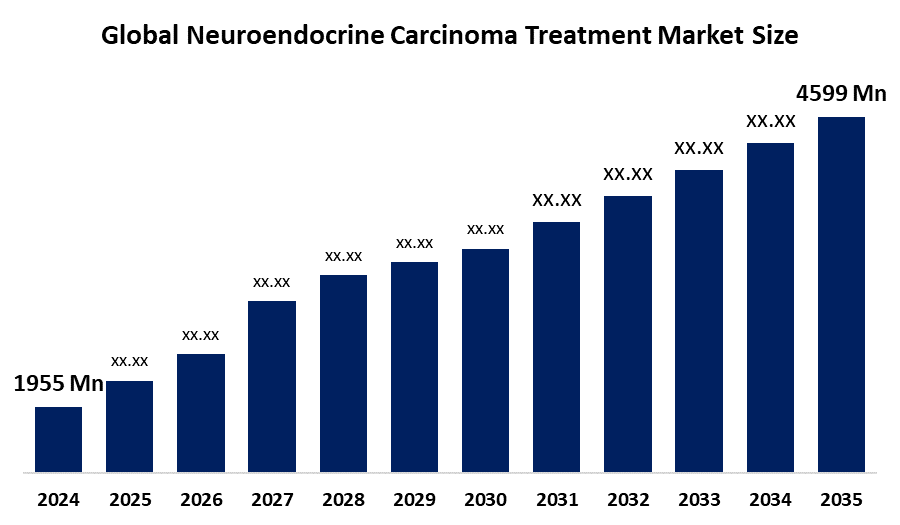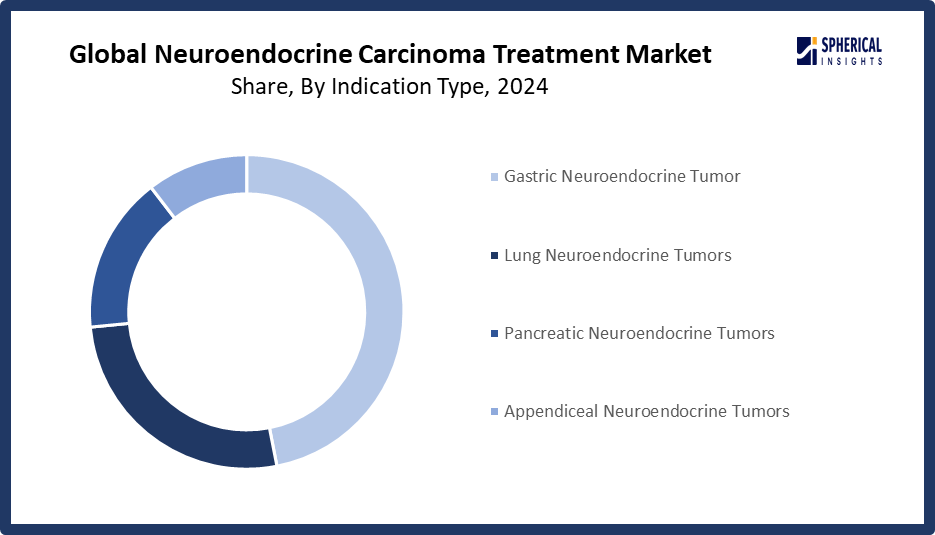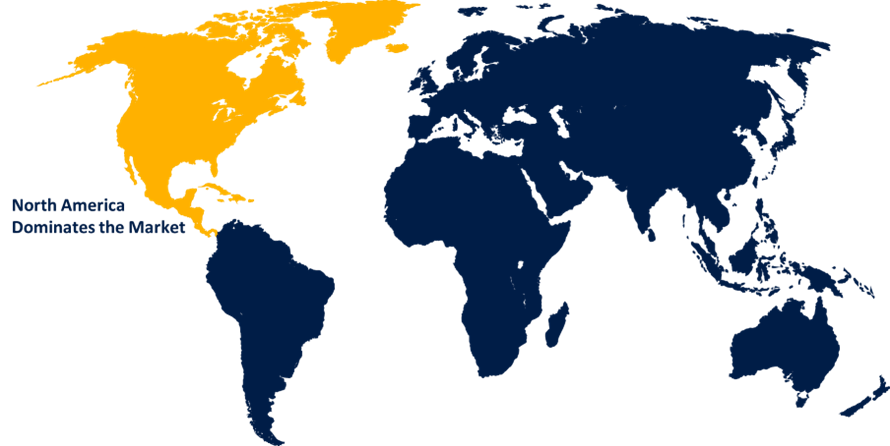Global Neuroendocrine Carcinoma Treatment Market Size, Share, and COVID-19 Impact Analysis, By Indication Type (Gastric Neuroendocrine Tumor, Lung Neuroendocrine Tumors, Pancreatic Neuroendocrine Tumors, and Appendiceal Neuroendocrine Tumors), By Treatment Type (Chemotherapy, Antimetabolites, Alkylating agents, Natural Products, Targeted Therapy, Tyrosine Kinase Inhibitor, mTOR Inhibitor, and Somatostatin Analogs), and By Region (North America, Europe, Asia-Pacific, Latin America, Middle East, and Africa), Analysis and Forecast 2025 - 2035
Industry: HealthcareGlobal Neuroendocrine Carcinoma Treatment Market Insights Forecasts to 2035
- The Global Neuroendocrine Carcinoma Treatment Market Size Was Estimated at USD 1955 Million in 2024
- The Market Size is Expected to Grow at a CAGR of around 8.09% from 2025 to 2035
- The Worldwide Neuroendocrine Carcinoma Treatment Market Size is Expected to Reach USD 4599 Million by 2035
- Asia Pacific is expected to grow the fastest during the forecast period.

Get more details on this report -
According to a research report published by Spherical Insights and Consulting, The Global Neuroendocrine Carcinoma Treatment Market size was worth around USD 1955 Million in 2024 and is predicted to grow to around USD 4599 Million by 2035 with a compound annual growth rate (CAGR) of 8.09% from 2025 and 2035. The market for neuroendocrine carcinoma treatment has a number of opportunities to grow due to improvements in diagnostic tools, like molecular profiling and improved imaging, which have made it possible to detect neuroendocrine tumors earlier and with greater accuracy. Treatment interventions that are timely and focused are made possible by this early detection.
Market Overview
Neuroendocrine carcinoma is a high grade, aggressive cancer that develops from neuroendocrine cells, which are cells that produce hormones and are present all over the body. Several factors impact the climate of the market, including an aging population who are more likely to be diagnosed with various forms of cancer. The National Cancer Institute reinforces the case for more efficacious treatment options by demonstrating that the incidence of neuroendocrine tumors in the US is approximately 6.98 per 100,000 persons. In addition, increased recognition of the numerous ways neuroendocrine tumors can manifest in patients by clinicians has led to earlier detection and improved patient outcomes. Targeted therapies, including peptide receptor radionuclide therapies and somatostatin analogs, have encouraged a positive outlook for the market. In addition, because of the rising incidence of neuroendocrine tumors in geriatrics, another opportunity for market growth exists. The U.S. Census Bureau estimates that, by 2060, there will be 95 million adults aged 65 years and older thus, this group will continue to grow and may be at greater risk for neuroendocrine tumors and other cancers. Specialized therapies and health services will be necessary to address the needs of this aging population, as is indicated by this trend.
Governments and authorities are approving new treatments and designations more frequently in an effort to speed up the development of NET treatments. Based on the results of the CABINET Phase III trial, the FDA authorized cabozantinib in March 2025 for advanced neuroendocrine tumors that had also been treated. Additionally, the first Peptide Receptor Radionuclide Therapy, Lutathera, received FDA approval for the treatment of adult somatostatin receptor positive gastroenteropancreatic NETs. Pediatric patients aged 12–17 were granted this approval by the FDA in April 2024.
Report Coverage
This research report categorizes the neuroendocrine carcinoma treatment market based on various segments and regions, forecasts revenue growth, and analyzes trends in each submarket. The report analyses the key growth drivers, opportunities, and challenges influencing the neuroendocrine carcinoma treatment market. Recent market developments and competitive strategies such as expansion, type launch, development, partnership, merger, and acquisition have been included to draw the competitive landscape in the market. The report strategically identifies and profiles the key market players and analyses their core competencies in each sub-segment of the neuroendocrine carcinoma treatment market.
Global Neuroendocrine Carcinoma Treatment Market Report Coverage
| Report Coverage | Details |
|---|---|
| Base Year: | 2024 |
| Market Size in 2024: | USD 1955 Million |
| Forecast Period: | 2025-2035 |
| Forecast Period CAGR 2025-2035 : | 8.09% |
| 2035 Value Projection: | USD 4599 Million |
| Historical Data for: | 2020-2023 |
| No. of Pages: | 245 |
| Tables, Charts & Figures: | 124 |
| Segments covered: | By Indication Type, By Treatment Type and By Region |
| Companies covered:: | Novartis AG, Pfizer Inc., Ipsen Pharma, Eli Lilly and Company, Roche, Boehringer Ingelheim GmbH, Bristol Myers Squibb Company, Amgen Inc., Exelixis Inc., Hutchison China MediTech, AVEO Pharmaceuticals, Jubilant Life Sciences, Sanofi S.A., Teva Pharmaceutical Industries, Merck & Co., Others, and |
| Pitfalls & Challenges: | Covid-19 Empact, Challenges, Growth, Analysis. |
Get more details on this report -
Driving Factors
The neuroendocrine carcinoma treatment market is driven due to an aging population, rising healthcare costs, and favorable regulations. This is accelerating the demand for home monitoring, assistive technology, and implants. Major innovations in healthcare, driven by artificial intelligence, precision medicine, and the use of sustainable technologies, are transforming healthcare and facilitating growth in the industry.
Restraining Factors
The neuroendocrine carcinoma treatment market is restricted by factors like the cost of advanced therapy treatment, which is a potentially limiting factor for patient access, especially in low-income regions.
Market Segmentation
The neuroendocrine carcinoma treatment market share is classified into indication type and treatment type.
- The gastric neuroendocrine tumor segment dominated the market in 2024, accounting for approximately 46.8% and is projected to grow at a substantial CAGR during the forecast period.
Based on the indication type, the neuroendocrine carcinoma treatment market is divided into gastric neuroendocrine tumor, lung neuroendocrine tumors, pancreatic neuroendocrine tumors, and appendiceal neuroendocrine tumors. Among these, the gastric neuroendocrine tumor segment dominated the market in 2024 and is projected to grow at a substantial CAGR during the forecast period. The segment is driven due to the increasing prevalence and improved diagnostic accuracy of stomach neuroendocrine tumors. Treatment response rates are increasing due to the development of tailored and targeted therapeutics. Patients are receiving better and timely treatments due to enhanced awareness and detection. As the therapeutic space for neuroendocrine carcinoma continues to grow, this is complemented by the therapeutic space of gastric neuroendocrine tumors, or carcinoids, benefiting from a focus on newer approaches and the associated supportive care, resulting in improved efficacy overall.

Get more details on this report -
- The somatostatin analogs segment accounted for the largest share in 2024, accounting for approximately 61.2% and is anticipated to grow at a significant CAGR during the forecast period.
Based on the treatment type, the neuroendocrine carcinoma treatment market is divided into chemotherapy, antimetabolites, alkylating agents, natural products, targeted therapy, tyrosine kinase inhibitors, mTOR inhibitors, and somatostatin analogs. Among these, the online segment accounted for the largest share in 2024 and is anticipated to grow at a significant CAGR during the forecast period. The dominance is due to its regulation of symptoms and halting or slowing tumor growth. The continued use of somatostatin analogs is an emerging treatment practice in clinical settings. The ongoing advances and the use of new formulations make the somatostatin analogs a popular treatment in gastroenterology.
Regional Segment Analysis of the Neuroendocrine Carcinoma Treatment Market
- North America (U.S., Canada, Mexico)
- Europe (Germany, France, U.K., Italy, Spain, Rest of Europe)
- Asia-Pacific (China, Japan, India, Rest of APAC)
- South America (Brazil and the Rest of South America)
- The Middle East and Africa (UAE, South Africa, Rest of MEA)
North America is anticipated to hold the largest share, representing nearly 45% of the neuroendocrine carcinoma treatment market over the predicted timeframe.

Get more details on this report -
North America is anticipated to hold the largest share, representing nearly 45% of the neuroendocrine carcinoma treatment market over the predicted timeframe. In the North America market, the situation is rising due to the region's advanced healthcare system, substantial healthcare expenditure, and prominent pharmaceutical companies collectively contributing to this position of prominence. This market leadership is mainly attributed to the U.S., particularly because of its strong research and development programs, coupled with favorable cancer treatment reimbursement policies. The area benefits from a high degree of awareness among patients and healthcare professionals, leading to earlier diagnoses and increased treatment rates.
The U.S. neuroendocrine carcinoma treatment market leads North America and is anticipated to earn a significant revenue share in 2024 due to its well-established healthcare system and significant research efforts. The presence of top research institutions and pharmaceutical firms expedites the creation and application of innovative therapies specifically designed to address neuroendocrine tumors. This environment promotes market competition for neuroendocrine tumor treatments and makes it easier for patients to get care.
Asia Pacific is expected to grow at a rapid CAGR, representing nearly 26% in the neuroendocrine carcinoma treatment market during the forecast period. The Asia Pacific area has a thriving market for Neuroendocrine Carcinoma Treatment due to the increasing incidence rates of NEC and other related cancers in the area, there is a growing need for effective treatment alternatives. Some of the increased incidence can be credited to improved diagnostic methods and increased health awareness, which allow for earlier and more accurate diagnoses, rather than a decline in treatment options. Improved access to innovative medicines is now possible, as a result of increased healthcare expenditure and enhanced healthcare infrastructure resulting from the economic development of various Asia Pacific countries. There has also been a significant level of investment in medical R&D throughout the region, especially in China, Japan, and India. These investments have stimulated innovation and the introduction of new therapies.
The European neuroendocrine carcinoma treatment market, representing nearly 14% reach a substantial market share in 2024, due to increased investment in research projects and healthcare infrastructure. European countries are attempting to improve diagnostic capabilities and give patients with neuroendocrine tumors access to state-of-the-art medications. This dedication is part of a broader movement to raise the standard of patient care as European healthcare systems adapt to rising incidence rates.
Competitive Analysis:
The report offers the appropriate analysis of the key organizations/companies involved within the neuroendocrine carcinoma treatment market, along with a comparative evaluation primarily based on their type of offering, business overviews, geographic presence, enterprise strategies, segment market share, and SWOT analysis. The report also provides an elaborative analysis focusing on the current news and developments of the companies, which includes type development, innovations, joint ventures, partnerships, mergers & acquisitions, strategic alliances, and others. This allows for the evaluation of the overall competition within the market.
List of Key Companies
- Novartis AG
- Pfizer Inc.
- Ipsen Pharma
- Eli Lilly and Company
- Roche
- Boehringer Ingelheim GmbH
- Bristol Myers Squibb Company
- Amgen Inc.
- Exelixis Inc.
- Hutchison China MediTech
- AVEO Pharmaceuticals
- Jubilant Life Sciences
- Sanofi S.A.
- Teva Pharmaceutical Industries
- Merck & Co.
- Others
Key Target Audience
- Market Players
- Investors
- End-users
- Government Authorities
- Consulting And Research Firm
- Venture capitalists
- Value-Added Resellers (VARs)
Market Segment
This study forecasts revenue at global, regional, and country levels from 2020 to 2035. Spherical Insights has segmented the neuroendocrine carcinoma treatment market based on the below-mentioned segments:
Global Neuroendocrine Carcinoma Treatment Market, By Indication Type
- Gastric Neuroendocrine Tumor
- Lung Neuroendocrine Tumors
- Pancreatic Neuroendocrine Tumors
- Appendiceal Neuroendocrine Tumors
Global Neuroendocrine Carcinoma Treatment Market, By Treatment Type
- Chemotherapy
- Antimetabolites
- Alkylating agents
- Natural Products
- Targeted Therapy
- Tyrosine Kinase Inhibitor
- mTOR Inhibitor
- Somatostatin Analogs
Global Neuroendocrine Carcinoma Treatment Market, By Regional Analysis
- North America
- US
- Canada
- Mexico
- Europe
- Germany
- UK
- France
- Italy
- Spain
- Russia
- Rest of Europe
- Asia Pacific
- China
- Japan
- India
- South Korea
- Australia
- Rest of Asia Pacific
- South America
- Brazil
- Argentina
- Rest of South America
- Middle East & Africa
- UAE
- Saudi Arabia
- Qatar
- South Africa
- Rest of the Middle East & Africa
Frequently Asked Questions (FAQ)
-
1. What is the CAGR of the neuroendocrine carcinoma treatment market over the forecast period?The global neuroendocrine carcinoma treatment market is projected to expand at a CAGR of 8.09% during the forecast period.
-
2. What is the market size of the neuroendocrine carcinoma treatment market?The global neuroendocrine carcinoma treatment market size is expected to grow from USD 1955 Million in 2024 to USD 4599 Million by 2035, at a CAGR of 8.09% during the forecast period 2025-2035.
-
3. Which region holds the largest share of the neuroendocrine carcinoma treatment market?North America is anticipated to hold the largest share of the neuroendocrine carcinoma treatment market over the predicted timeframe.
-
4. Who are the top 15 companies operating in the global neuroendocrine carcinoma treatment market?Novartis AG, Pfizer Inc., Ipsen Pharma, Eli Lilly and Company, Roche, Boehringer Ingelheim GmbH, Bristol Myers Squibb Company, Amgen Inc, Exelixis Inc., Hutchison China MediTech, AVEO Pharmaceuticals, Jubilant Life Sciences, Sanofi S.A., Teva Pharmaceutical Industries, Merck & Co., and Others.
-
5. What factors are driving the growth of the neuroendocrine carcinoma treatment market?The neuroendocrine carcinoma treatment market growth is driven by the rising prevalence of neuroendocrine tumors and improvements in diagnostic tools like molecular profiling and improved imaging techniques, which have allowed for earlier and more precise detection. Artificial intelligence and single cell RNA sequencing are two examples of technological advancements that are transforming our understanding of NEC and opening the door to the creation of tailored treatment plans and targeted medicines.
-
6. What are the market trends in the neuroendocrine carcinoma treatment market?The neuroendocrine carcinoma treatment market trends include advancements in molecular diagnostics, rise of, radiopharmaceuticals in NEC therapy, targeted and immunotherapy development, rise in personalized medicine, and collaborative research initiatives.
-
7. What are the main challenges restricting wider adoption of the neuroendocrine carcinoma treatment market?The neuroendocrine carcinoma treatment market trends include regulatory obstacles, high treatment costs, few possibilities for reimbursement, and a lack of knowledge among medical providers. Access to medicines, prompt diagnosis, and the creation of standardized treatment procedures are all hampered by these circumstances.
Need help to buy this report?